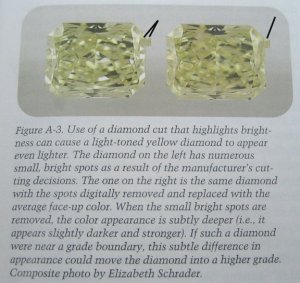- Joined
- Sep 3, 2000
- Messages
- 6,756
I often think about how many difficult decisions appraisers, dealers and consumers make in regard to color grading diamonds. These decisions have a large economic impact and also are part of the lack of trust felt between conumers and the trade.
Would you like the color of diamonds given in more precise steps than is presently the case with the D-Z GIA system? Crossover points will never be eliminated, but each diamond would be better defined.. Remember GIA color (and clarity) grades are closer together at the top.
Two alternative strategies for categorization could be employed:
1. Numerical grading in even steps. There would be more steps in the darker stones, but the higher quality diamonds would still be more precisely defined. This is the attached image.
2. an even number of numerical steps from color to color. This would finely tune the highest colors way beyond anything a person possibly detect.
Obviously, this sort of work cannot be done without high tech equipment. Would this be viewed as an improvment or just a further impediment to business?
In the long run, I would expect to see a migration to a more refined scale than what we use now. Right now, we have enough problems, and even high tech machines can't yet render 99% error free color grading.

Would you like the color of diamonds given in more precise steps than is presently the case with the D-Z GIA system? Crossover points will never be eliminated, but each diamond would be better defined.. Remember GIA color (and clarity) grades are closer together at the top.
Two alternative strategies for categorization could be employed:
1. Numerical grading in even steps. There would be more steps in the darker stones, but the higher quality diamonds would still be more precisely defined. This is the attached image.
2. an even number of numerical steps from color to color. This would finely tune the highest colors way beyond anything a person possibly detect.
Obviously, this sort of work cannot be done without high tech equipment. Would this be viewed as an improvment or just a further impediment to business?
In the long run, I would expect to see a migration to a more refined scale than what we use now. Right now, we have enough problems, and even high tech machines can't yet render 99% error free color grading.












300x240.png)